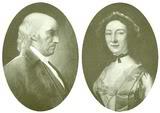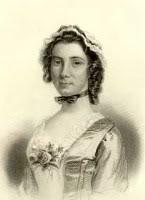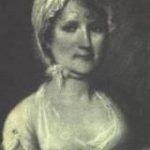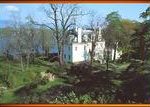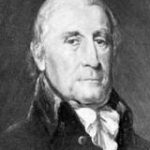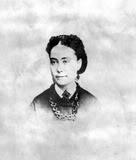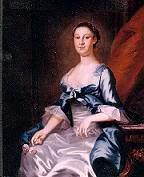Wife of Declaration of Independence Signer Lewis Morris
Lewis and Mary Walton Morris
Mary Walton came from a notable family of New York merchants. Her father was Jacob Walton who had married Maria Beekman, daughter of Dr. Gerardus Beekman. With his brother William, Jacob carried on the business that had been founded by their father.
Lewis Morris, the third Morris to be named Lewis, was born in New York in 1726, the eldest son of Lewis and Catherine (Staats) Morris. His father was the second lord of the vast manor of Morrisania. His great grandfather, Richard Morris, had purchased the first tract of land in southwest Bronx that became the basis for the Morrisania manor. Upon graduating from Yale College in 1746, Lewis returned to his father’s residence, where he devoted himself to the pursuits of agriculture and helped manage the estate.
On September 24, 1749, Lewis Morris married Mary Walton, enhancing his already great fortune. They had ten children, six sons and four daughters: Catherine, Mary, Lewis, Jacob, Sarah, William, Helena, James, Staats, and Richard. Sons, Lewis, Jacob, and Richard fought in the Revolutionary War, and son William served as aide-de-camp to General Anthony Wayne.
Mary Walton Morris was an eminently capable woman, and notwithstanding her wealth and social position, was a well-trained and thrifty housewife. She actively entered into the rural life that her husband had chosen for them.
After his father died In 1762, Lewis, the eldest son, inherited Morrisania and became its third lord. He devoted himself to the management of his large estate and became a successful farmer. About this time, he gained an interest in local politics, and in 1769 served a term in the colonial legislature.
It was surprising that this child of fortune, who enjoyed his life as a country gentleman, identified himself with the movement for independence of the American colonies. Though he lived in the pro-Loyalist county of Westchester, Morris became increasingly critical of British policy.
In 1775, Morris helped organize a meeting at White Plains that overcame strong opposition and chose county delegates, including Morris as chairman, to New York’s Convention (revolutionary government). That body elected him to the Continental Congress (1775-77), where he worked on the committees that supervised supplies of ammunition and military stores for the Army.
When conflict began, Morris sided with the patriots, in many cases, against his wealthy neighbors. He convinced local politicians to send representatives to the re-formed Legislature in April of 1775. That congress appointed delegates to the Second Continental Congress, and Morris was one. He served on committees for the defense of New York, one for provisioning colonial forces, and another for Indian affairs. These tasks carried him throughout New England in the first few years of the war.
On May 15, 1775, he took his elected seat to the Second Congress. He was placed on a committee, chaired by General Washington, to devise ways and means to supply the colonies with ammunition and military stores. At the close of the session, he was sent west to assist in the difficult operation of detaching the Indians from their British allies, and inducing them to take the side of the colonists. He remained at Fort Pitt until the following winter, and maintained a constant correspondence with Congress on the subject of Indian affairs.
Returning to New York, Morris found that the people of the province, especially those in the city, did not sympathize with him in his desire for independence, and that Governor Tryon, although he had been compelled to take refuge on board the British fleet in the harbor, still managed to keep the minds of the citizens in a state of hesitancy.
For most of 1776, Morris was absent from Philadelphia, serving as a brigadier general in the Westchester County militia, and was often torn between his duties in the Congress and those to the defense of his own colony. With other patriotic gentlemen, he induced the Committee of Safety to prohibit, under severe penalties, any interaction with the royal fleet.
During the critical vote for independence on July 2, 1776, Morris was in New York, but he attended the New York Convention at White Plains, which approved the Declaration of Independence on July 9. The actual signing of the document occurred on August 2, when most of the 56 members of Congress place their names on the parchment copy.
Lewis Morris should have stayed in New York warding off an impending British attack on New York. Instead, he returned to Philadelphia to sign the Declaration – though he knew that a large British army had landed within a few miles of his estate, that their armed ships were lying within cannon shot of his homestead, and that his extensive possessions would probably be pillaged.
When warned by his brother of the consequences that would follow his signing of the rebellious document, Morris stated, “Damn the consequences, give me the pen!”
![]()
Lewis Morris’ Signature
On the Declaration of Independence
After he signed the Declaration, Morris became a marked man. The Redcoats burned more than a thousand acres of his woodland, ransacked his house, forced his family to flee for their safety, captured his livestock, dispersed his domestics and tenants, and laid waste to the entire property. He would spend many years after the war rebuilding his estate.
Early in 1777, Morris relinquished his seat in congress to his younger half-brother, Gouverneur Morris, and his colleagues passed a resolution complimenting him “for his long and faithful services.” For the next six years, Morris and his family suffered many privations, until the British evacuated New York City in 1783. At times, he and his family were in actual want.
Morris returned to his local duties in 1777, in order that he might bring his personal influence to bear upon the citizens of New York to sustain the cause of independence, showing them that he was himself a willing sufferer. He served as a county judge (1777-78) and a New York senator in the new state government (1777-81 and 1784-88), and sometimes was in the field with the state militia.
On Evacuation Day, November 25, 1783, the last vestige of British authority in the United States – including the Redcoats – left Manhattan. The last shot of the Revolutionary War was fired on that day, as a British gunner on one of the departing ships fired a cannon at jeering crowds gathered on the shore of Staten Island, at the mouth of New York Harbor (the shot fell well short of the shore).

Manor of Morrisania
Westchester County, New York
Morris returned home, and devoted much of his time to repairing and rebuilding Morrisania. All of the Morris land and nearly all of his wealth had been destroyed during the Revolution. He was a member of the first Board of Regents for New York University from 1784 until 1798.
In 1787, Lewis’ brother, Gouverneur Morris, wrote much of the final draft of the U.S. Constitution. Lewis attended the convention in Poughkeepsie, and strongly supported Alexander Hamilton’s drive for approval of the Constitution. Thanks largely to Lewis Morris’ efforts, a narrow vote of 30 in favor to 27 opposed was achieved, bringing New York into the union as the eleventh state.
In 1790, Lewis Morris offered the land, now part of the South Bronx neighborhood of Morrisania as the site of the US capital.
Lewis Morris died on January 22, 1798, at his estate, Morrisania, at the age of 71.
Mary Walton Morris and her distinguished husband are buried in the family vault in the yard of St. Anne’s Episcopal Church in the Bronx.
The Morris family’s landholdings in The Bronx are some of the oldest in the state and date back to 1670. New York City annexed the family’s property in 1874, and sections of Morrisania were used to create Crotona and St. Mary’s Parks, as well as other New York City parklands.
SOURCES
Walton Park
Allexperts: Mary Walton
Lewis Morris
Mary Walton Morris
Lewis Morris Biography
Wikipedia: Lewis Morris
Lewis Morris 1726 – 1798
Biography of Lewis Morris
Descendant Bios – Signer Lewis Morris
Lewis Morris: Signer of the Declaration
Representing New York at the Continental Congress
